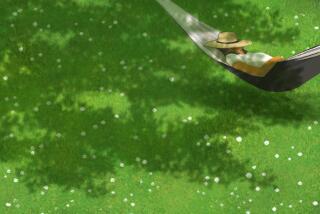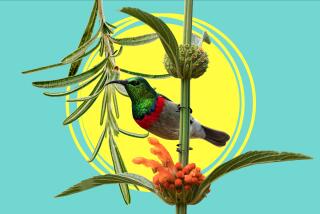GARDENING : Plants Take a Position on Sunny vs. Shady Spots
- Share via
People with shady yards often have their own idea about what “full sun” and “part shade” mean.
A friend whose yard is surrounded by tall trees once planted a grapevine in what he called a sunny spot--where the leafy tree canopy allowed a window of sunlight to peek through for about an hour at 12:30!
The grapevine grows, but produces just a few sour grapes. Grapes need full sun, and full sun means direct, unobstructed sunlight for at least six hours a day. This is the kind of exposure vegetable gardens, most fruit trees and many flowers require.
Some plants are adapted to shade when they are young, but require more light as they age. This is true of maples, beeches and other forest trees that start out as seedlings in the shade of existing forests, but eventually reach light and become the canopy itself.
Shade not only decreases flowering and fruiting of plants that need sun, but also causes their leaves and stems to become succulent. You put this to practical use when you block light from the stalks or leaves of celery or endive to make them more tender.
And then there are plants that actually abhor full sunlight. African violet is native to shaded, tropical forests, and its leaves burn if exposed to full sun.
In other cases, shade-loving plants do not require shade itself, but, rather, the coolness and humidity of shade. Blueberries grow wild in the shade, but bear more berries if grown in full sun--as long as their roots are kept moist and cool, with a thick mulch, for example.
Similarly, you can extend your lettuce harvest into summer by covering the plants with either shade cloth or a frame made from strips of wood.
“Part shade” (or “part sun”) occurs when a canopy of leaves blocks the sun, or when plants grow near enough to buildings to receive sun for only part of the day.
The east side of walls receives only morning sun, which is cool year-around and well-suited to broadleaf evergreens such as mahonia and rhododendron. Such plants would scorch against a west wall, which is more suited to thyme, potentilla, santolina and other plants that tolerate the hot fury of late afternoon sun.
Plants near north-facing walls receive diffuse light and, in summer, a bit each of early morning and late afternoon sun. This wall will be dark in winter, but as the days get longer the sun wraps more and more around the sky, shedding more direct light on the wall early and late in the day.
The effect increases with increasing latitude, and is how British gardeners get away with growing cherries as espaliers trained on north walls. (The coolness of the north wall also delays blossoming, so the flowers have an increased chance of escaping damaging late spring frosts.)
Don’t be disappointed if you realize that some of your “full sun” is, in fact, “part shade.” Plenty of plants enjoy the dappled play of sunlight through tree branches, or the coolness of northern or eastern walls.
In fact, shade-lovers are represented by every category of plant: deciduous woody plants such as Juneberry, honeysuckle, dogwoods and witch hazels; evergreen woody plants such as mountain laurel, rhododendron, azalea, and euonymus; vines such as Boston and English ivy; perennial flowers such as bleeding heart, columbine, daisy, primrose and violets; and annual flowers such as impatiens and begonia.
There even are fruit trees that will produce in part shade. Persimmon and papaw tolerate dappled shade, and hardy kiwi fruits, gooseberries and currants actually enjoy it, especially where summers are hot.
Even dense shade need not hamper your gardening. Ferns and other woodland plants are especially adapted to such habitats, as are cultivated plants such as vinca.
There even are flowers to brighten up full shade: cardinal flower, day lily and bee balm.






